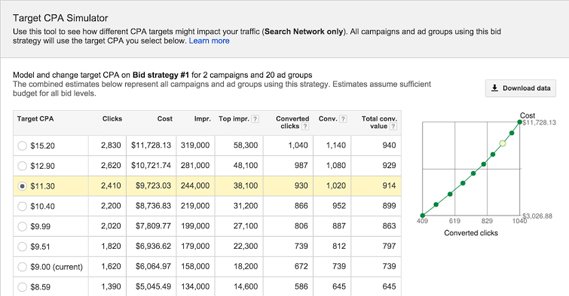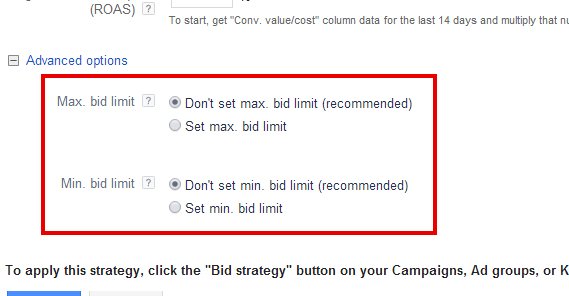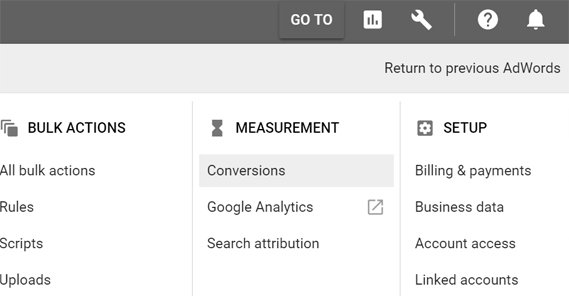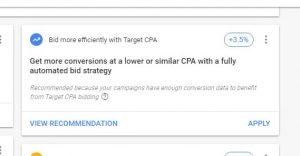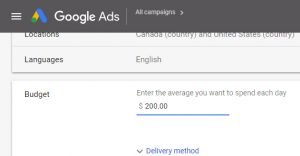Can Switching to CPA Bids in Google Ads Hurt Conversions?

Google Ads have a number of different bidding strategies. One of them, most commonly known as Target CPA Bidding, is an automatic bidding strategy. Can changing your bidding strategy to CPA Bidding hurt your conversions?
About Target CPA Bidding
Target CPA Bidding with Google Ads is a “smart” bidding strategy, which means it’s automatically optimized by Google algorithms, rather than your own micromanagement. Google uses an array of data sources, including your ad past performance, your goals, and general ad performance across similar keywords to determine what their bidding strategy should be for your ads.
Each different Automatic bidding strategy focuses on optimizing your ads for a different metric. For example, you can optimize for conversions instead of costs, or for clicks over conversions. If you’re running an awareness campaign, you’d prefer a higher volume of clicks, versus a higher percentage but lower volume of conversions.
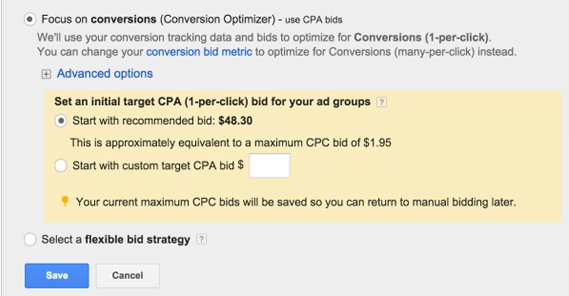
With Target CPA bidding, you’re being optimized to get as many conversions as possible, so long as those conversions are at or below a given cost threshold. This means you might be able to set a higher cost cap and get more conversions, but since you don’t want to spend that much per conversion, you’re getting fewer conversions than you otherwise might.
Note that according to Google’s help center, Target CPA bidding optimizes for average cost per action/conversion, rather than individual prices. If you’re optimizing for $1-per-conversion, and Google gets multiple 50-cent conversions, it means they have the flexibility to get $2 or more conversions, so long as it averages out to at most $1 each.
In practice, this isn’t important. So long as the average cost remains where you want it, it doesn’t really matter if you’re getting 100 conversions at that price exactly, or 50 at a lower and 50 at a higher price. You’re still paying the same amount overall for the same number of conversions, within certain bounds.
Target CPA Settings
When you’re setting up ads using Target CPA bidding, you have a handful of different settings you can specify to attempt to guide your ad performance.
First up, you have the target CPA itself. If you want to average $1 conversions, your target CPA should be $1. Again, this is an average, so you might get some 10 cent conversions and you might get some $5 conversions, so long as the sum total of all conversions divided by the number of conversions averages out to $1.
Using a low target CPA can hurt conversions.
If you set $1 as your threshold, but the average cost per conversion in your niche is closer to $2, you’ll have far fewer conversions than you otherwise could. A target bid that’s too low will mean you’re being out-bid in the ad auction for your best converting audience.
Google will attempt to recommend an ideal target CPA when you set up your ads, based on historical data for similar ads you have run in the past. This target suggestion will be calculated based on the past few weeks of performance; data too much older than a month isn’t useful to current ad auctions.
Secondly, you can specify bid limits. You can set both a minimum and a maximum bid limit. For example, if you know that any conversions obtained with a bid under 10 cents are going to be worthless to you as a whole, you can set a higher minimum to eliminate those low bids. Conversely, if you know that extremely expensive conversions rarely end up worthwhile, you can set a maximum bid cap to cut those out.
Google does not recommend setting bid limits for automatic bidding strategies, because it restricts flexibility. If you set a $3 bid cap for your target $1 CPA, automatic bidding will not be able to give you those $5 conversions, even if it keeps your average under $1. This results in a lower number of conversions. You must use portfolio ads rather than standard ads to set bid limits.
You can choose to adjust your target CPA based on device. This is essentially a prioritization system. If you know that your mobile users are most valuable to you as customers, you can set a focus on mobile users, with less priority given to desktop ad auctions. These adjustments are percentile, meaning you can adjust the value of a given platform up by however much % you want, and down by a maximum of 100%. If you adjust a platform to -100%, those ads will be eliminated. A -100% adjustment to mobile, for example, will force your ads to only display on desktop and tablet devices. Those are the only three categories; mobile, desktop, and tablet.
You are also able to choose to only pay for conversions, rather than pay for positioning in the ad ranks. Paying for conversions has its own slate of benefits and drawbacks, which you can read about here.
Does Switching to Target CPA Hurt Conversions?
To go back to the initial question, as posed in the title of this post, does switching to target CPA hurt your conversions?
The answer is “it depends”, and it depends entirely on the settings you use and the settings you’re changing away from.
For example, if you used manual CPA bidding prior to the change, you may lose many of the optimizations you have made, and be reverted to a more average line of bidding. This can result in fewer conversions, or a lower average conversion value, due to your optimizations being wiped.
On the other hand, if you’re switching from a manual bidding strategy that has been working quite poorly for you, the switch to automatic bidding can increase your conversions, as well as increasing the average conversion value.
In part, this depends on the target CPA settings you’ve chosen. If you set lower bid caps, a lower target CPA, or a higher required value for your target conversions, you are likely to get fewer conversions overall. Conversely, if automatic optimizations allow you to open up your bids to spend your money as best as possible, Google will likely be able to get you more conversions than you were with your manual optimizations.
The Benefits of Target CPA Bidding
One of the biggest benefits of using an automatic bidding strategy is saving yourself both time and money. As long as you set bid caps to prevent over-spending, and you set a target CPA that sits firmly in the middle of your plausible conversion range, you should be able to get more conversions for the same budget as with manual bidding.
This is because Google’s algorithms can take in data on an ongoing basis and make adjustments to your bidding automatically throughout the day. They can even dynamically adjust bidding based on user performance from hour to hour. If you were to try to make these optimizations manually, you would be adjusting on the fly constantly throughout the day. It would be a full time job.
Chances are good that switching to an automatic bidding strategy will get you more conversions than using a manual strategy, while also saving you time. However, it may not save you money, and depending on your settings, it might not get you as many conversions.
In general with the automatic ad auction, if you increase your target CPA, you will get more conversions. It’s not even a complicated equation. If you have more money to spend, you’ll get more people coming in. It will, of course, increase your average cost per conversion.
Achieving Success with Target CPA Bidding
If you’re interested in using target CPA bidding or another automatic strategy, I can give you some tips to help your initial forays be a success.
First up, how long should you experiment with a bidding style before making a determination as to its effectiveness? I generally recommend about a month. 30 days will get you a good set of data, so long as you aren’t operating in a niche with very strong seasonality. Obviously, it’s hard to run a viable experiment comparing a data set that isn’t equal to another. A heavily Christmas-themed niche is going to have vastly different performance numbers comparing 30 days in November to 30 days in June.
I also recommend that you be careful with split testing and incremental changes. Usually, incremental changes and optimizations help increase performance for ads. However, with automatic CPA bidding, Google considers both past and current performance to determine bids. If you make a change, Google will be considering data from both before and after the change when deciding on bidding strategies. You have to wait until the older data falls off to see how the change really impacted performance. This applies to ad targeting, ad copy, and even ad placement.
You should also be careful with setting your target CPA much lower than Google’s recommended target CPA. You will generally end up leaving a lot of conversions on the table if you do so. The other aspects of your ads will need to make up for the lack of budget, meaning they have to be incredibly compelling, which may not be plausible. You will have a lower cost per conversion, but also a lower volume of conversions.
Another decision you have to make is whether you want your ads to appear in search or in the display network. PPC Hero studied this and found that, usually, display ads performed better with target CPA bidding. A target CPA in a reasonable range usually ended up close to or slightly over the target average with display ads, while it ended up much higher – up to 106% more than the target average – with search ads. This may vary based on niche or performance, of course, but it seems consistent that display ads are cheaper.
Paying Attention to Valid Metrics
One thing you need to keep in mind when you’re choosing a bidding strategy and various bid caps is what your targets should be.
Do you want to focus on a specific cost per action? You are free to do so with target CPA bidding, but be aware that you may end up with fewer conversions on average. If you care more about the cost per conversion than you do about the number of conversions, this can be a good way to balance out your advertising costs.
Do you want to focus on a specific value of conversions? Using other automatic bidding strategies, you can optimize for the value of a conversion. If you know that fewer conversions with higher average value is a better result for your company than a larger number of smaller value conversions, this can be a good option. This is particularly useful if user support or account maintenance is a huge money sink, and your high value customers are where your profits come from.
Do you want to focus on a specific volume of conversions? Setting a target CPA is likely to give you fewer conversions than keeping your CPA open and aiming for as many conversions as possible. You simply need to be aware that if your CPA rises too high, you may end up spending more on customer acquisition than you profit from those customers.
Always know which metrics you want to monitor before you start creating your ads. While you can always adjust your bids and bidding strategies later, it’s always best to have a foundation in mind before you begin.
 ContentPowered.com
ContentPowered.com
